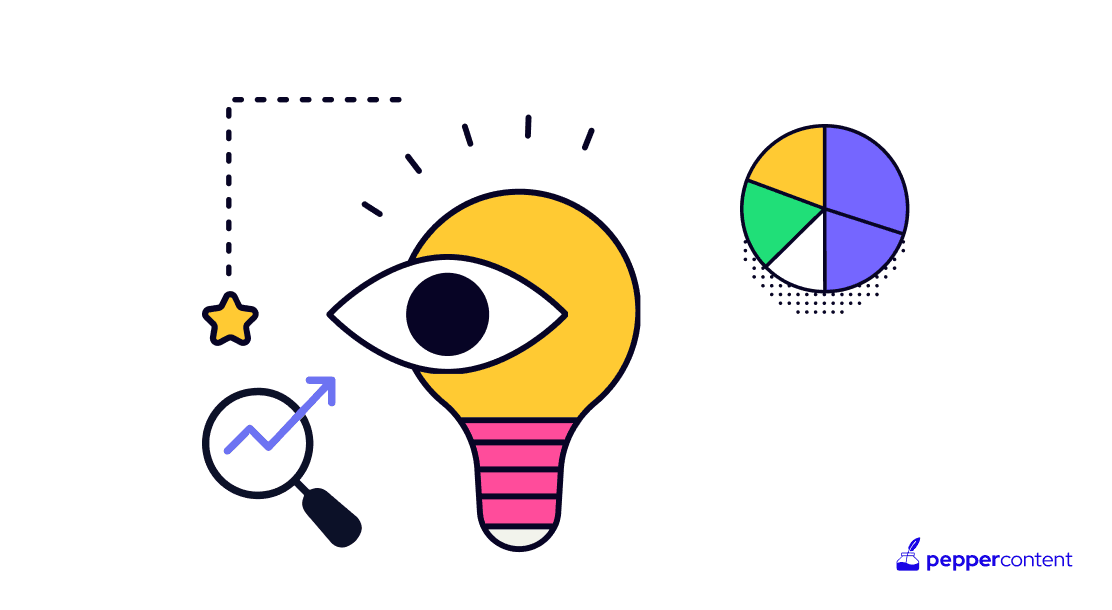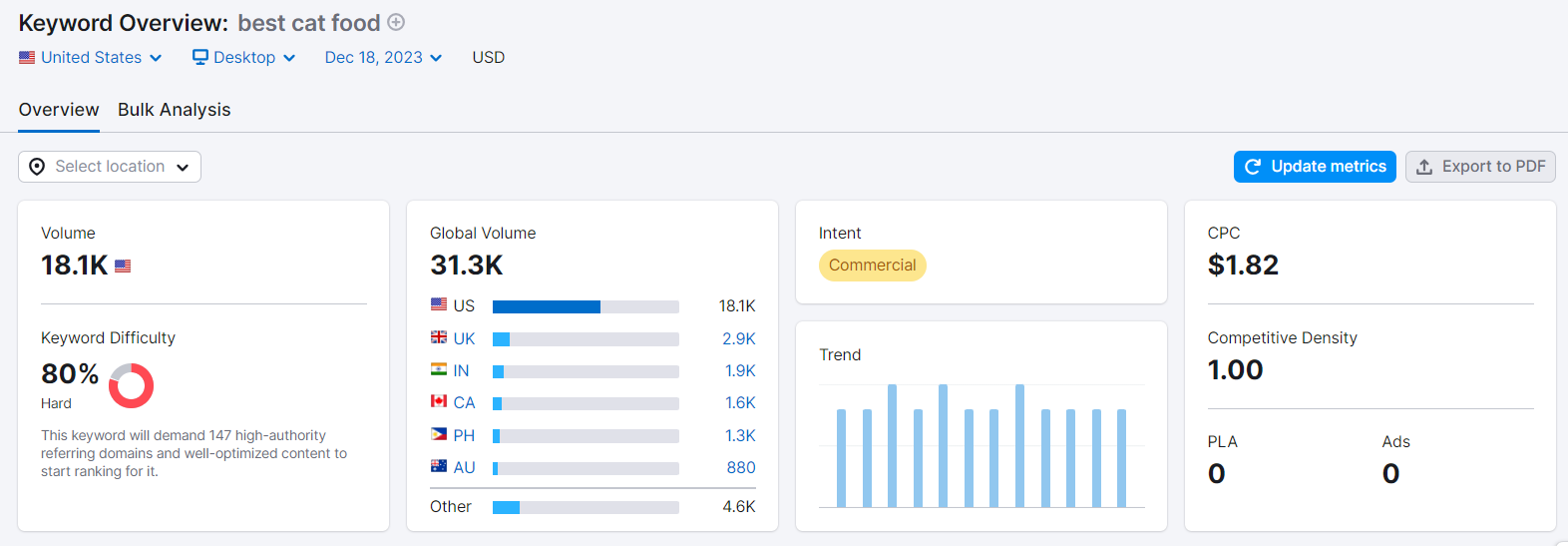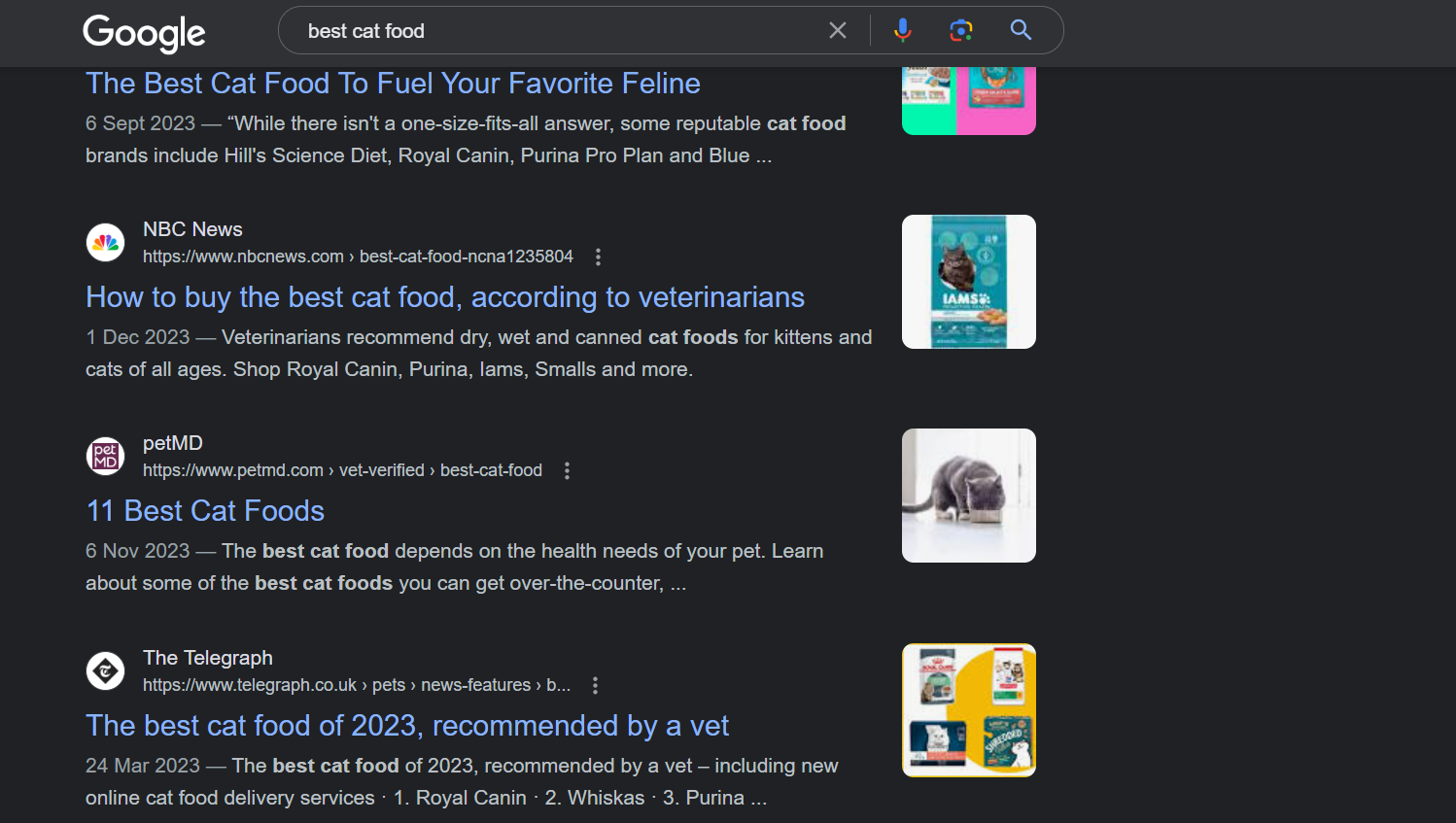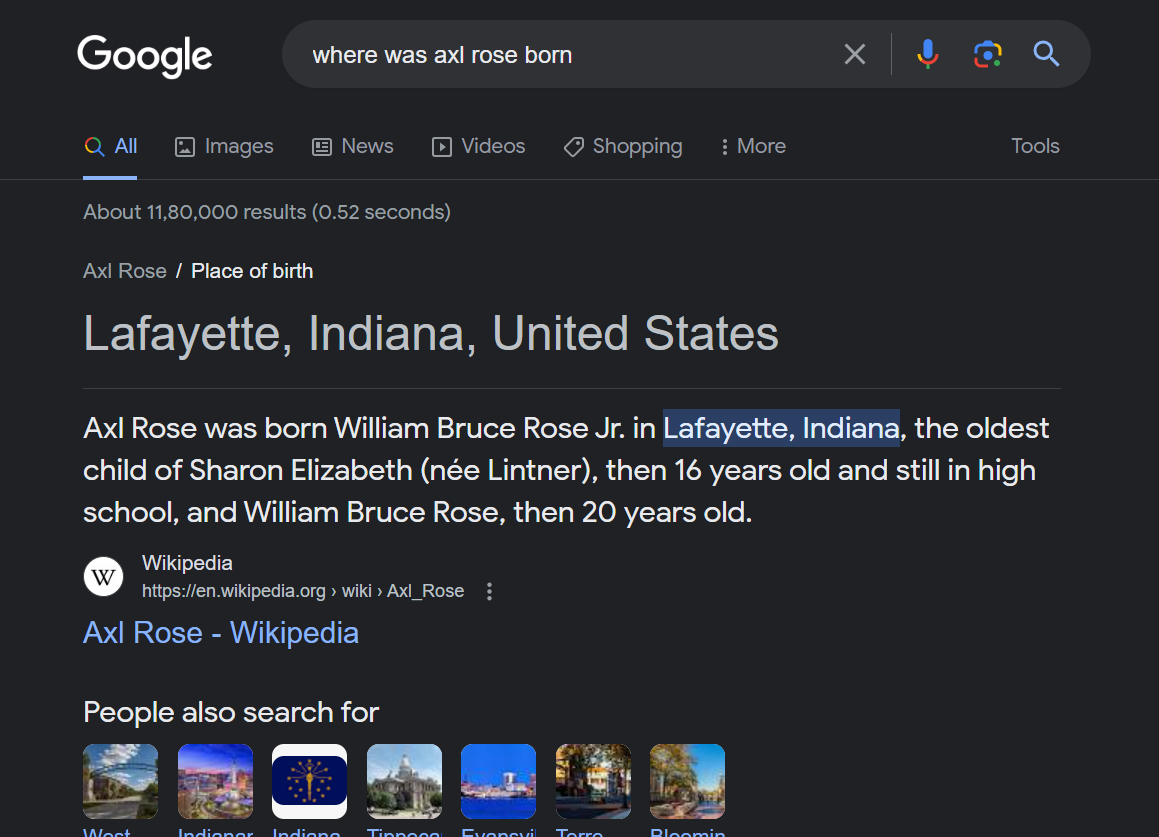What is Search Intent and Why is it Fundamental to SEO?

Are you struggling to get better visibility of your content on Google? You’ve likely come across the concept of ‘search intent’ or keyword intent, also called user intent, while refining your SEO approach.
But, for those who are new to it, what is search intent? In this article, we’ll explore search intent, why it is fundamental to SEO, and how you can use it to your advantage!
What is Search Intent?
When someone types a query into a search engine, it’s because they have a goal in mind, known as search intent or user intent. It reflects what the user aims to achieve with their search—whether it’s finding an answer to a question, discovering a specific website, making a purchase, or exploring a topic.
For instance, consider a search for “best cat food” on Google. In this case, the user isn’t trying to reach a particular webpage, nor are they ready to buy a specific product—at least not immediately.
They intend to gather information before making a purchase. This indicates a commercial intent behind the keyword. Understanding user intent allows us to adapt our content better to target this keyword.
Importance of Search Intent in SEO
Search engines, such as Google, prioritize providing relevant results to users. Hence, recognizing search intent significantly influences your potential to secure a higher ranking in search results.
To improve your chances of ranking on Google, it’s crucial to ensure that your web pages align with the search intent behind the targeted keywords. A comprehensive understanding of search intent can benefit you in several ways:
-
Enhanced Content Strategy: Tailor your content strategy by targeting keywords that resonate with the needs of your target audience.
-
Relevant Content Creation: Understand your users’ requirements and develop content that addresses those needs effectively.
-
Improved Search Rankings: Show search engines that your content is valuable and relevant to their users, thereby increasing your likelihood of ranking higher in search results.
To demonstrate, let’s revisit our initial example. The keyword “best cat food” boasts 31,300 monthly searches. Now, imagine you run an e-commerce site specializing in pet food.

Wouldn’t it be fantastic to secure a high ranking for this keyword using the product page featuring your best-selling cat food brand? It sounds appealing, but unfortunately, it’s not feasible.
Upon looking at the Google results, it becomes evident that Google doesn’t categorize “best cat food” as a transactional keyword. The results displayed predominantly consist of review articles spotlighting the top cat food brands, with no e-commerce websites in sight.

Consequently, if you try to rank with a product page, it would be impractical in this context, irrespective of its initial relevance.
Understanding the Types of Search Intent
There are four types of search intent: Navigational, Informational, Commercial, and Transactional.
By understanding these types of search intent, content creators and website owners can tailor their strategies to better meet users’ needs. Here’s a breakdown of the key types of search intent:
1. Navigational Intent
Navigational intent refers to a user’s desire to locate a particular webpage or website. Unlike other types of search intent, individuals with navigational intent already have a clear understanding of what they are searching for.
Examples of keywords associated with navigational intent include:
-
tim hortons
-
yahoo login
-
semrush keyword magic tool
-
Amazon exchange policy
These queries are typically branded and direct, focusing on a specific destination. The primary goal is to ensure users can quickly locate a particular page or website when needed.
Navigational search intent plays a key role in shaping online strategies, particularly for businesses and content creators with established brand identities. Organizations can streamline the user’s journey by recognizing the significance of navigational queries and implementing optimization techniques, contributing to a positive online experience and strengthening brand loyalty.
2. Informational Intent
Informational search intent signifies users seeking to acquire knowledge or learn something specific. These searches are often framed as questions and typically contain words like who, what, where, why, and how. Understanding and leveraging informational search queries are integral to a robust SEO strategy.
Examples of keywords with informational intent include:
-
brad pitt movies
-
what is search intent
-
mumbai time now
Google often provides direct answers to more specific questions in the SERP, as seen in this example:

However, blog posts remain the primary content type for many informational queries. This highlights the importance of incorporating blogging into your SEO strategy.
Here are some of the major benefits of targeting informational keywords:
-
Visibility: Informational queries constitute a significant portion of searches on Google. To enhance visibility, it’s essential to address these queries as part of your content strategy.
-
Building Trust: Providing valuable information and educating your audience establishes trust in your expertise. By becoming a reliable source of information, you can strengthen your relationship with users.
-
Targeting New Leads: Content focused on informational keywords has the potential to attract new leads. While direct conversions may not be immediate, capturing the attention of users interested in learning builds a foundation for future conversions.
While ranking for informational queries may not directly result in a surge of conversions, it offers a valuable opportunity to grow your business in several ways. Visibility, trust-building, and the potential to attract new leads are substantial benefits that contribute to the overall success of your online presence. Including informational content in your SEO strategy is a strategic move to cater to the diverse needs of your audience and establish your brand as an authoritative source in your industry.
3. Commercial Intent
Commercial search intent refers to the keywords your audience uses when they are in the research phase before making a purchase. They are positioned between informational and transactional intent, and users with commercial intent seek information closely tied to an impending action.
Examples of keywords with commercial intent include:
-
best cat food
-
macbook air review
-
amazon prime vs hulu
-
best content marketing tools
In commercial intent searches, users explore options, read reviews, and compare products or services. The search results often feature third-party pages containing independent reviews, making it challenging to rank for commercial keywords relevant to your brand.
While ranking for commercial keywords can be challenging, implementing effective marketing strategies and utilizing tools such as Semrush’s Surround Sound can help your brand remain visible during the crucial decision-making process of potential customers.
By providing valuable and relevant content, optimizing for search engines, and leveraging various promotional channels, businesses can influence and guide users toward choosing their products or services. Understanding the dynamics of commercial search intent is key to developing a successful online presence in a competitive landscape.
4. Transactional Intent
Transactional search intent signifies that users have a specific action in mind, and this action aligns with the goals you, as a business owner, want them to take.
Contrary to the name, this intent isn’t limited to purchases alone. Users engaging in transactional searches might seek to perform actions like completing a newsletter signup or downloading software.
Examples of keywords with transactional intent include:
-
samsung galaxy watch price
-
adhd test online
-
trello trial
Transactional keywords are often the catalysts for conversion. These are the words your potential customers use when they are ready to take the next step. By strategically incorporating transactional keywords into your digital strategy, you can effectively guide users toward the desired conversions and meet your business objectives.
The Three Cs of Search Intent
Understanding and aligning with user search intent is key to ensuring your content aligns with the user journey. To achieve this, it’s essential to delve into the Three Cs of search intent: Content Type, Content Format, and Content Angle.
1. Content Type
Content Type refers to the prevalent format or category of content that dominates search results for a particular query. Identifying the dominant content type enables content creators and marketers to tailor their strategies to meet user expectations effectively. For example,
-
Blog post
-
Video
-
Product page
-
Category page
-
Landing page
2. Content Format
Content Format goes beyond the type and dives into the preferred presentation style or structure of content. Users often gravitate towards specific formats like how-to guides, list posts, reviews, or videos.
By identifying the preferred format, content creators can optimize their material to match user preferences.
3. Content Angle
Content Angle refers to the distinctive perspective or unique selling point that sets top-ranking content apart. It involves understanding why certain content rises to the top of search results and identifying the angle that captures user interest.
Recognizing the content angle offers creators a fresh perspective or unique value proposition.
Optimizing Content for Search Intent
Optimizing content to resonate with search intent involves strategic planning, meticulous analysis, and a commitment to meeting user expectations. Here are essential steps to ensure your content is finely tuned to user intent:
-
Start by conducting thorough keyword research to identify the terms and phrases your target audience is likely to use. Categorize these keywords based on informational, navigational, commercial, or transactional intent.
-
Analyze the SERP for your target keywords. Identify the types of content that consistently appear at the top and understand the user intent behind these results.
-
Tailor your content to match the dominant content types for a given query. If blog posts are prevalent, create detailed and informative articles. If videos dominate, consider incorporating video content into your strategy.
-
Identify the preferred content format for your target audience. Whether it’s how-to guides, listicles, reviews, or videos, align your content format with what users are more likely to engage with.
-
Beyond focusing on the main topic, addressing subtopics is equally important for providing informative resources that fulfill user expectations.
-
Craft content with the user in mind. Anticipate user needs and questions, and provide answers and solutions within your content. This approach enhances user satisfaction and engagement.
While identifying key subtopics and refining content strategies, it’s important to conduct content gap analysis by leveraging SEO tools, exploring related queries, and incorporating user feedback.
You can use SEO tools such as SEMrush, Ahrefs, or Moz to identify content gaps. These tools can reveal keywords, topics, and subtopics relevant to your niche and audience.
When it comes to getting user feedback, gather insights directly from your audience through surveys and feedback mechanisms. Understand their needs, pain points, and the information they seek, and incorporate these insights into your content strategy.
Enhancing User Experience with Search Intent
Enhancing user experience with search intent involves a thoughtful combination of user-centric design and strategic content optimization. To improve user experience, you need to limit the usage of intrusive elements such as pop-ups, ensuring that they do not disrupt the user’s journey or restrict content consumption. Additionally, using clear and informative subheadings helps users navigate content easily, providing a structured and digestible format.
Another crucial aspect is revisiting and re-optimizing existing content to align more effectively with search intent. To achieve this, you must regularly update and refine your material based on evolving user expectations, incorporating relevant subtopics and ensuring the content remains current and valuable.
By maintaining a balance between a user-friendly design and content that aligns seamlessly with search intent, you create an online environment that ranks well in search results and fosters a positive and engaging experience for your audience.
The Role of SERP Analysis in Search Intent
Understanding user intent is fundamental to effective SEO, and one powerful tool for finding intent is Search Engine Results Page (SERP) analysis. Analyzing SERPs provides valuable insights into user behavior and preferences, shedding light on the types of content that best align with specific queries. Whether it’s blog posts, videos, product pages, or other formats, recognizing these patterns helps tailor content to match user expectations.
The integration of automated tools further streamlines the process, offering efficiency, precision, and scalability in understanding and aligning with the diverse intentions of online users.
The integration of automated tools, such as those provided by SEO platforms, can analyze vast datasets to determine the intent behind specific queries. These tools consider factors like keyword semantics, user behavior, and historical data, thus offering efficiency, precision, and scalability in understanding and aligning with the diverse intentions of online users.
Applying Search Intent in Different Stages of the Marketing Funnel
The marketing funnel typically consists of three key stages: Awareness, Consideration, and Conversion. Here’s how you can map and leverage search intent at each stage:
1. Awareness Stage
In the awareness stage, users explore and discover. Their search queries often revolve around broad topics and informational content. They may seek answers to questions, educational resources, or general information related to your industry.
Tailor your content strategy to provide informative and educational resources that address your target audience’s initial questions and concerns. Blog posts, infographics, and how-to guides can effectively capture attention and build brand awareness.
2. Consideration Stage
At the consideration stage, users have narrowed their options and actively compare products, services, or solutions. Their search queries may include terms like “best,” “compare,” or “reviews.”
Create content that compares different offerings, provides in-depth reviews, and offers valuable insights to aid users in their decision-making process. Video content, comparison guides, and detailed product/service reviews influence consideration.
3. Conversion Stage
In the conversion stage, users are ready to decide and act. Their search queries become more transactional, including terms like “buy,” “order,” or “subscribe.”
Align your content strategy with transactional intent by offering actionable and transactional content. This may involve optimizing product pages, creating clear calls-to-action (CTAs), and facilitating a seamless user journey toward conversion.
By understanding and strategically applying search intent at different marketing funnel stages, businesses can create a cohesive and targeted digital marketing strategy that effectively guides users from initial awareness to final conversion. This approach enhances user experience and maximizes the impact of marketing efforts at each crucial stage of the customer journey.
Challenges and Solutions in Understanding Search Intent
Understanding search intent is a complex task that comes with its own set of challenges. However, with the right tools and strategies, businesses can overcome common pitfalls and adapt to changes in user behavior and search engine algorithms.
One challenge involves the ambiguity inherent in user queries, making it difficult to understand their needs based solely on the search query precisely. The solution lies in leveraging context clues and employing semantic analysis to understand the questions.
Additionally, integrating natural language processing tools can enhance the understanding of user intent by unraveling the complexities within the language used.
Another pitfall emerges from the dynamic nature of user intent, which evolves with changing trends, preferences, and industry landscapes. To address this, businesses should regularly analyze and update their keyword strategies, staying informed about industry developments to adjust content accordingly and align with shifting user expectations.
Lastly, the diverse intents encapsulated within single keywords further complicate accurate interpretation. Mitigating this challenge involves incorporating long-tail keywords to capture more specific user intent and considering the broader context of keywords within the overall content strategy.
Tools and Techniques for Accurate Intent Analysis
Accurate analysis of user intent in online searches relies on employing various tools and techniques, including:
SEO Platforms and Analytics
Platforms like Google Analytics and SEO tools such as SEMrush or Ahrefs play a key role in segmenting user behavior, tracking keyword performance, and offering valuable insights into the intent behind specific queries.
By leveraging these tools, businesses can gain actionable data to refine their content strategies and align with user expectations effectively.
Natural Language Processing (NLP)
NLP tools and libraries, such as spaCy or NLTK, introduce a sophisticated layer to intent analysis. Integrating NLP allows marketers to dive into the semantic context of search queries, revealing the subtleties and insights that might be present in user intent.
This deeper understanding enables businesses to craft content that not only aligns with the explicit meaning of queries but also resonates with the underlying context.
Intent Categorization Tools
Intent categorization tools provided by SEO platforms represent another critical component in pursuing accurate intent analysis. These automated tools categorize keywords based on intent, streamlining the analysis process and providing marketers with a systematic approach to understanding user goals.
By efficiently categorizing keywords, businesses can tailor their content strategies more effectively, ensuring alignment with the diverse intentions of online users.
Businesses can navigate shifts in user behavior and search engine algorithms by combining continuous monitoring, user feedback integration, and algorithmic awareness into their keyword categorization approach, optimizing their digital strategies for sustained success.
Wrapping Up
Search intent is one of the most important factors when it comes to ranking your content and neglecting your potential users’ needs jeopardizes your chances of sustained visibility.
Without a keen understanding of search intent, the prospects of long-term ranking are reduced significantly. Hence, it is key to make it a mission to fulfill search intent, aligning your content precisely with the needs of searchers. By doing so, you will meet user expectations effectively, and search engines, including Google, are likely to reciprocate with favorable rankings.
Looking for high-quality SEO writing services? Look no further because Pepper Content is here to take care of all your content needs. Contact us today to win the SERPs.
Latest Blogs
Learn how to rank on AI search engines like ChatGPT, Perplexity, and Gemini by optimizing your content for authority, structure, and relevance. Stay ahead in AI-driven search with this strategic guide.
Explore the best healthcare SEO services for your medical practice. Improve online visibility and effectively reach more patients in need of your services.
Discover top social media agencies specializing in banking solutions, enhancing financial services and driving engagement.
Get your hands on the latest news!
Similar Posts

Organic Marketing
8 mins read
Oops, I Think I SEO’d Too Much! What is Search Over-Optimization and How to Fix It

Organic Marketing
9 mins read
What is AMP? A Beginner’s Guide to AMP Pages & SEO

Organic Marketing
8 mins read